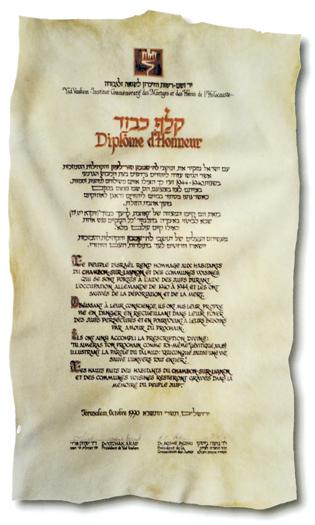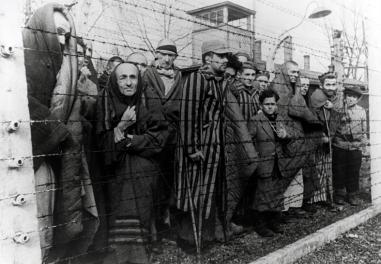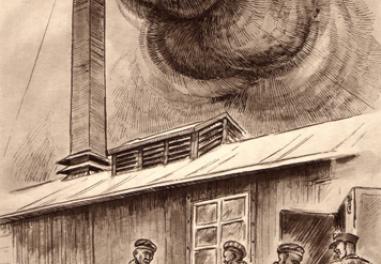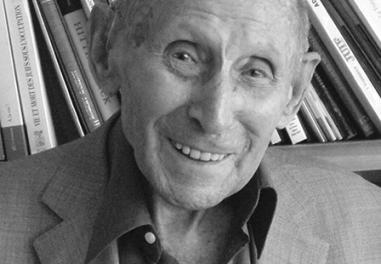A land of the Righteous
During the Occupation, the residents of Le Chambon-sur-Lignon and the neighbouring villages saved many Jews. It was such a unique example of civic and spiritual resistance on such a scale that the town and the region received a diploma of honour from Yad Vashem in 1990.

Le Chambon-sur-Lignon and the vicinity are located in the Haute-Loire department, on a 1,000-metre plateau, a mainly Protestant area where, since the 1900s, tourists and children have enjoyed the fresh air. Le Chambon is a family resort with "boarding houses" and "children's homes". In June 1940, the armistice and the internment of foreign Jews were decried by the pastors of Le Chambon, André Trocmé and Édouard Théis, while Pastor Charles Guillon, Mayor of the village, resigned so as not to be a "Vichy Mayor" and dedicated his life to helping the refugees. Thanks to his knowledge of the international organisations in Geneva, where he was the Secretary General of the Young Men's Christian Association, he received financing for the houses opened in Le Chambon. Starting in 1941, with assistance from relief agencies and an authorisation from the Prefecture, these pastors encouraged the opening of houses in Le Chambon to welcome internees from the southern zone (children, teen-agers and students, mothers and the elderly, foreign Jews, anti-Nazis and Spanish Republicans) as well as vulnerable children, including Jews released from the camps or placed by relief agencies.
But during the summer of 1942, with roundups being organised in the southern zone, these "monitored residences" that housed many foreign Jews were highly exposed. They were dispersed in the surrounding villages, hamlets and isolated farms. The pastors, schoolteachers, secretaries at the town hall, gendarmes, farmers, doctors, hoteliers and boarding house owners, of all faiths, everyone contributed more or less actively to the rescue operations. This civic and spiritual resistance progressively became clandestine. The refugees now had to be given false identity papers, the most vulnerable were exfiltrated to Switzerland. By word of mouth, the Plateau became a base for the refugees, so much so that today it is impossible to know how many of them came through here and were saved – at least several thousand.
In August 1944, the country was liberated, the refugees left the Plateau, and young resistance fighters returned to civilian life or joined the liberation army. In the children's houses, some were reunited with their parents or their families, the orphans were placed in the care of the relief agencies. The story of Le Chambon, like that of the Shoah, had long remained buried in their memories. But at the end of the 1970s, a group of former refugees realised the unique nature of this large-scale rescue operation, at a time when a process of memorial and greater understanding of the Jewish genocide began in France. They had a commemorative plaque placed across from the Temple on 17 June 1979, marking the beginning of the memory of Le Chambon, involving the former refugees and residents who often discovered the scope of the actions undertaken clandestinely.
In France, personalities who had worked on the Plateau were among the first to receive the medal of the "Righteous among the Nations". The idea of a collective medal was put forward at the Comité Français, but the Yad Vashem Institute can only honour individuals – it is awarded to a non-Jewish person who, at the risk of his or her own life, helped Jews persecuted by the Nazi occupant. Exceptionally, in 1990, Yad Vashem presented a diploma in "homage to the residents of Le Chambon-sur-Lignon and the neighbouring communities who gave assistance to Jews during the Occupation and saved them from deportation and death". These are the only communities in France to have received this diploma.
In June 2013, Le Chambon-sur-Lignon opened a place of remembrance (for further information, see www.memoireduchambon.com) to transmit this exemplary history, a unique site in Europe dedicated to the history of the Righteous and the various forms of resistance during World War II.
Read more
Museum :
Articles of the review
-
The file

1945, horror revealed
In the first months of 1945, the Allied armies liberated the Nazi camps one by one and discovered the scope of the massacres. In April, pictures of the horror were transmitted around the world and the survivors' repatriation was organised. Yet it took years to understand the reality of the concentra...Read more -
The event

Natzweiler-Struthof Concentration Camp
Read more -
The interview

Georges Loinger
Georges Loinger, now 104 years old, was one of the leaders of the Œuvre de secours aux enfants (OSE – Children's Aid Society) during the Occupation, which organised the rescue of several thousand Jewish children. This great French resistance fighter remembers the reasons behind his commitment and hi...Read more

